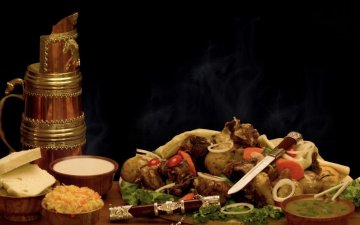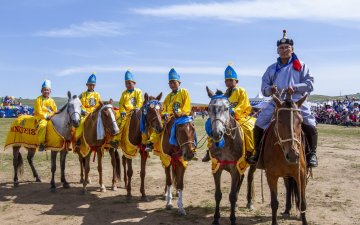Mongolian food is certainly not very well known. High in meat and flour, and with lots of added dairy products. Like so much in Mongolia, its food and especially the way it’s consumed is a reflection of the traditional nomadic lifestyle. Put simply, the short summers are when you fatten up for those long harsh winters when temperatures drop to -20’C for months on end and energy supplies run low. Nomads survived the harsh winters on a protective layer of fat and a diet of dried dairy products and meat produced over the summer months.
Come spring, they’d purge out the accumulated cholesterol and consume high protein winter. Vitamins came through the meat and milk of animals that grazed on a wide variety of grasses and plants. And so the cycle continued.
Mongolian cuisine is heavy on meat, which is generally boiled and not grilled or fried. Mutton from the famous fat-tailed sheep is the most common meat and its bulbous tail is considered a real delicacy, similar to bacon but not as greasy.
Bactrian, or two humped, camel is on the menu in the desert south and beef, including yak, in the mountainous north. Goat is also popular but horse and fish are rarely eaten. Chicken and pork are modern additions.
Dumplings stuffed with cooked mutton are the best known Mongolian dish as ubiquitous as the Australian meat pie or American hamburger and come in three versions. Buuz is steamed, bansh is boiled and khuushuur is deep fried in mutton fat.
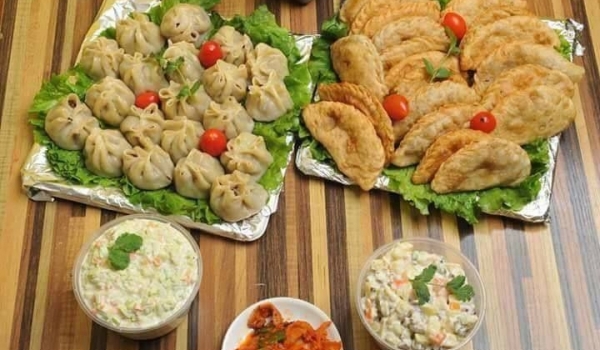
Other traditional dishes always in generous proportions are meat with fresh noodles or rice and a variety of stews and soups, often heavy with potatoes and carrots. For a quick snack, these hit the spot - but you will be amazed how many khuushuur your hosts can put away. On the road, these foods are typically served at roadside stops, often in gers or wooden buildings called guanz. But even the flashiest restaurants in Ulaanbaatar offer dumplings.
At the top of the culinary list - certainly one of the most memorable you will experience if you are lucky enough to have it - is boodog, an exotic goat dish deeply immersed in Mongolian tradition and offered only on special occasions. First, the goat’s entrails and bones are removed and the carcass filled with herbs and hot stones, its neck tightly tied to act as a pressure-cooker. The carcass is then placed over coals to cook for two or three hours. When the goat is ready, the gathered guests are each given a piping-hot and slightly sticky stone, typically round and black, straight from the carcass, which you toss back and forth in both hands “for good luck”. A delicious broth is served and then the tender and flavoursome meat takes center stage at the banquet that follows. Anyone offered this dish should feel deeply honoured.
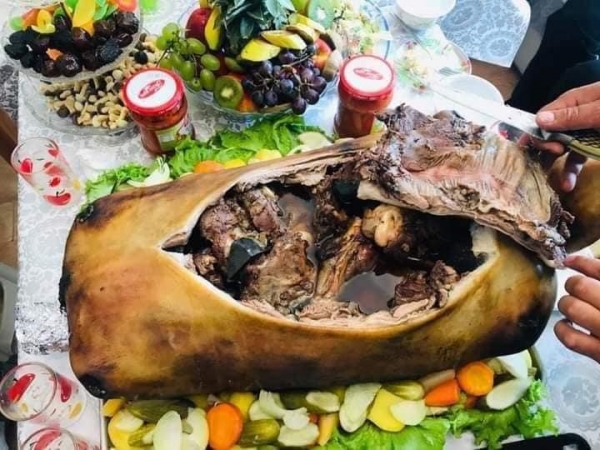
A simpler and more popular version - known as khorkhog - uses the fat tailed sheep, ideally the whole animal. Again with hot stones, chunks of meat and vegetables such as potatoes and carrots are placed in a tightly sealed metal pot and cooked over a hot fire. In a remarkably quick time, usually a half-hour or so, the meat comes out tender and full of flavour.
Another popular addition to meals is dried meat, or borts, usually mutton, which is cut into long strips and hung to air-dry. The preserved meat lasts up to a year and is cut or ground as an additive to soups and other meals. Most famously, borts was placed under the saddle of warriors heading off to battle and tenderized in that manner.
Milk products. There are some 40 different kinds of cheese and milk products. Typically, these include:
yogurts (tarag)
Clotted cream (urum)
Hard creamy cheeses (byaslag and eezgii)
Melted butter (shar tos) and those dried curds seen desiccating on the sunny roofs of gers called aaruul.
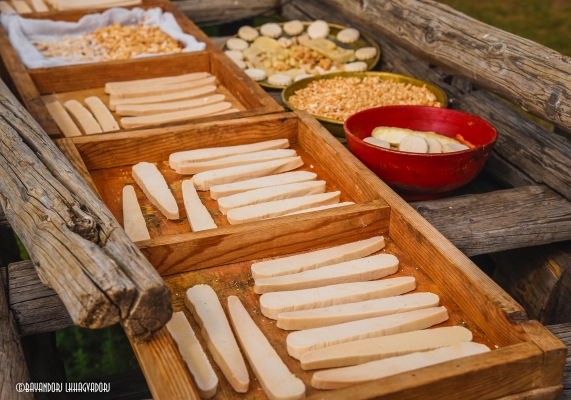
This is also when the legendary drink airag, known elsewhere as “kumis”, is produced from mare’s milk. Tangy and slightly fizzy, the drink has the alcohol content of beer and, like fine wines, differs widely in taste depending on the region, with the airag from Saikhan sum in Bulgan aimag the most famous.
All these, plus hard candies and biscuits, are typically offered to visitors by ger families. The creamy tarag is a particularly tasty and delicious yogurt, while aaruul is repeatedly very good for the teeth and makes a great “trail mix” as your travels continue.
A more elaborate seven-step process distills milk into a traditional spirit called shimiin arkhi. Like other Asians, Mongolians lack a particular enzyme to break down strong alcohol, and thus they produce this relatively weak spirit, certainly far less concentrated than the later imported vodka. Served warm, shimiin arkhi has the rough alcohol content of wine. But because a large amount of its remaining fat is not distilled, heavy consumption is treacherous, including causing blindness.
Mongolians are very fond of tea, which is served year-round and at any time of the day either straight green or black, with splinters of little twigs, or more often with milk. In some regions the milky tea is also salted or slightly buttered, while some households like flavouring it with roasted flour or grain, reputedly as a hangover cure. With Mongolia’s constant winds, tea is always refreshing, warming up the body and providing it with salt.
New articles
9 Reasons to Travel to Mongolia
- It's the home of living nomadic culture
- The vast, untouched steppe
Deel (traditional clothing)
The traditional mongolian outfit, or Deel, is primarily practical. It warms a horse rider’s back and the long coat protects the rider’s legs and knees from the cold.
Mongolian Food and Beverages
Mongolian food is certainly not very well known. High in meat and flour, and with lots of added dairy products.
Traditional Naadam Festival
Mongolians used to organize Naadam festivals to celebrate rituals such as holding a great Khuraldai (meeting of rulers), enthroning a king, worshiping the sky or going to war.


